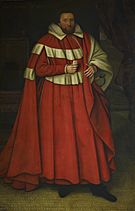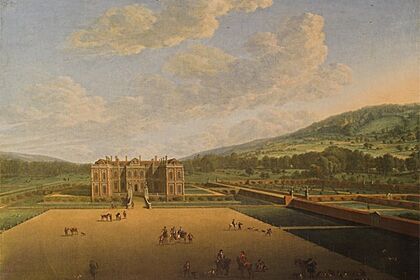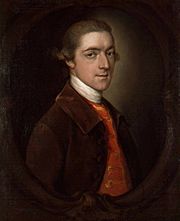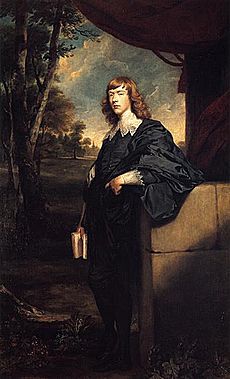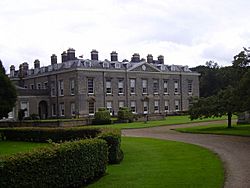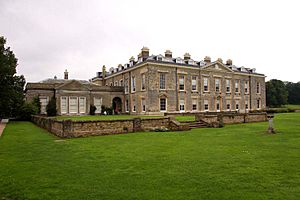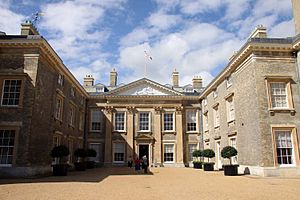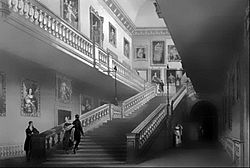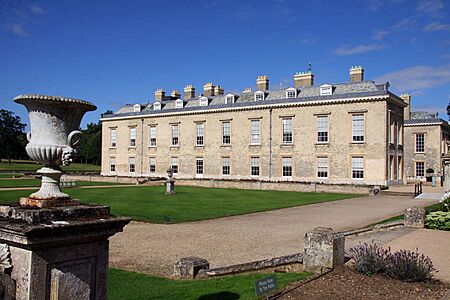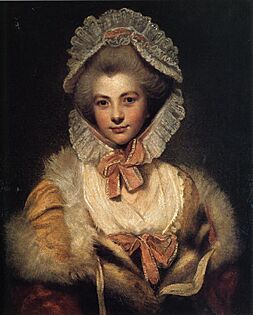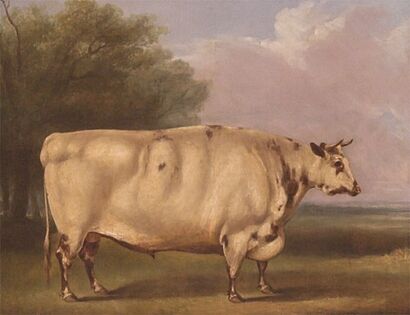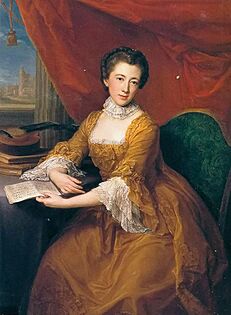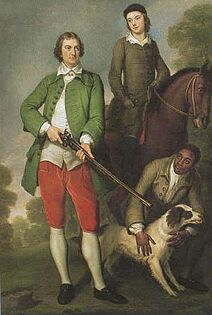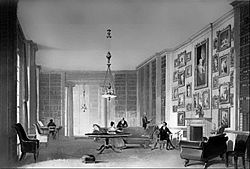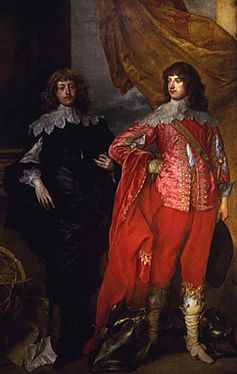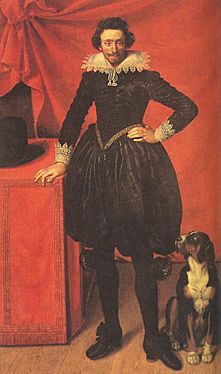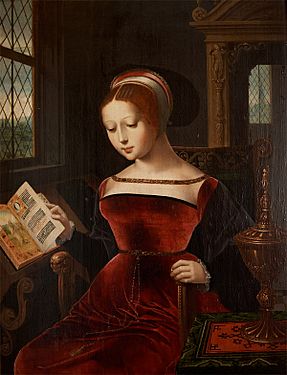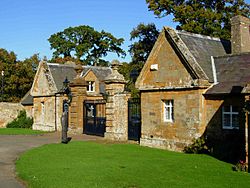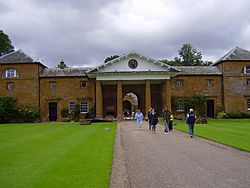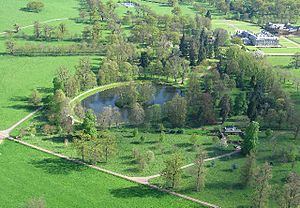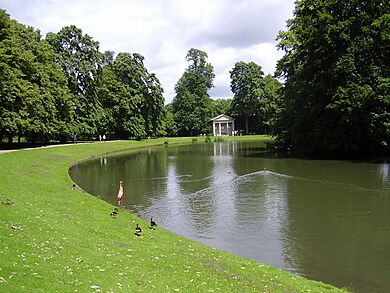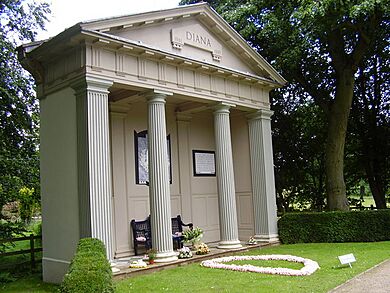Althorp facts for kids
Quick facts for kids Althorp |
|
|---|---|
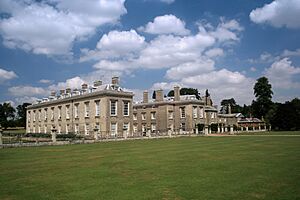
Althorp in July 2006
|
|
| Location | Althorp, Northamptonshire |
| Rebuilt | 1688 |
| Owner | Spencer family |
| Lua error in Module:Location_map at line 420: attempt to index field 'wikibase' (a nil value). | |
Althorp is a beautiful old house and estate in West Northamptonshire, England. It covers about 13,000 acres (53 square kilometers). By road, it's about 6 miles (10 km) northwest of Northampton and 75 miles (120 km) northwest of central London. The estate is located between the villages of Great Brington and Harlestone.
The Spencer family has owned Althorp for over 500 years. Since 1992, Charles Spencer, 9th Earl Spencer has been the owner. Althorp was also the home of Lady Diana Spencer (who later became Princess of Wales) from the time her parents divorced until her marriage to Charles, Prince of Wales (who is now King Charles III).
Althorp is mentioned in the Domesday Book of 1086 as a small village called "Olletorp." By 1377, it had grown to more than fifty people. However, by 1505, no tenants lived there anymore. In 1508, John Spencer bought the Althorp estate. He used money from his family's sheep-rearing business.
Althorp became one of the most important stately homes in England. The current house was built in 1688, replacing an older one that King Charles I once visited. The Spencer family collected a huge amount of art and other valuable items. In the 1700s, the house was a major social spot in England. Many important people from Britain's ruling class came to parties there.
George John, 2nd Earl Spencer, who owned Althorp from 1783 to 1834, built one of the largest private libraries in Europe at the house. By the 1830s, it had over 100,000 books! Later, in 1892, John Spencer, 5th Earl Spencer, known as the Red Earl, sold much of this collection to Enriqueta Rylands for the University of Manchester Library. Many of Althorp's furnishings were sold in the 1900s. Between 1975 and 1992 alone, about 20% of the house's contents were sold at auction.
The house at Althorp was originally a beautiful red brick Tudor building. But its look changed a lot starting in 1788. The architect Henry Holland made big changes. Special tiles were added to the outside, covering the brick. Four large columns were also added to the front. The main entrance hall, Wootton Hall, is considered one of the most impressive rooms in the county. A large dining room was added in 1877. Many fireplaces and furnishings were brought to Althorp from Spencer House in London during the Blitz (World War II bombings) to keep them safe. They are still there today.
The Picture Gallery is 115 feet (35 meters) long and is on the first floor. It's one of the best examples of the original Tudor oak wood in the house. It has a huge collection of portraits, including famous paintings like War and Peace by Anthony van Dyck. In the 1980s, about £2 million was spent on redecorating the house. During this time, most of Althorp's religious paintings were sold.
The Althorp estate has 28 listed buildings and structures. These include old planting stones. The former falconry, built in 1613, is a very old and important building. The stable block, designed by Roger Morris in the 1730s, is also a notable building. The French landscape architect André Le Nôtre designed the park and grounds in the 1660s. More changes were made in the late 1700s by Henry Holland.
After the death of Diana, Princess of Wales in 1997, she was buried on a small island in the middle of the Round Oval lake. A special temple with Diana's name on it is across from the lake. It's a place where visitors can leave flowers. The house and estate are open to the public in July and August.
Contents
What's in a Name?
Althorp was a small village in medieval times. In the Domesday Book, it was called "Olletorp." This name likely meant "Olla's Thorp," referring to a medieval lord named Olla. "Thorp" is an old word from Scandinavia that probably meant "daughter's settlement." In the 1200s and 1400s, it was called "Holtropp" and "Aldrop." When John Spencer bought the estate in 1508, it started to be called "Oldthorpe."
Today, the name is often pronounced "Awl-thorp." However, the current owner, Charles Spencer, has said that his family usually pronounces it "Awl-trupp." When he took over in 1992, the BBC Pronunciation Department contacted him, and they agreed on the "Awl-thorp" pronunciation for public use.
A Look Back in Time
Early Days
A small village called Althorp existed here long ago, probably on the southwest side of the park. It was first mentioned in the Domesday Book in 1086, with ten people living there. It was part of the Brington area. By 1377, fifty people over 14 paid a tax there. But in the 1400s, the village population shrank. By 1505, no tenants lived there. Much of the land was turned into sheep pastures by 1577.
In 1469, John Spencer's uncle, also named John Spencer, became a feudal lord of Wormleighton Manor and a tenant at Althorp in 1486. The Spencer family was well-known for managing their estates and their sheep business made a lot of money. John Spencer bought Althorp in 1508 for £800 from the Catesby family. At that time, Spencer owned many other properties too. It took about four years to set up the park, which included 300 acres of grassland, 100 acres of woodland, and 40 acres of water.
When John Spencer died in 1522, his youngest son, Sir William Spencer, took over. He held it until his death in 1532. William's son, John Spencer, inherited Althorp and passed it to his son, also John, in 1586. This John's son, Robert, became the 1st Baron Spencer of Wormleighton in 1603.
Anne of Denmark and Prince Henry visited Althorp on June 25, 1603. They were on their way to Windsor Castle from Edinburgh. The famous writer Ben Jonson created a special show for the Queen.
King Charles I also visited Althorp. The drawing room was built and the main hall made bigger for his visit. A huge amount of money, £1,300, was spent on the banquet. After Robert Spencer died in 1627, Althorp went to William Spencer, 2nd Baron Spencer of Wormleighton. His eldest son, Henry Spencer, 1st Earl of Sunderland, fought in the Battle of Edgehill in 1642. He was given the title of Earl of Sunderland in 1643, which cost him £3,000. He was killed in battle later that year at just 23 years old.
After Henry's death, the estate went to his son Robert Spencer, 2nd Earl of Sunderland, who was only two years old. Robert built the current house in 1688 and made changes to Althorp park. However, Robert had a bad temper and was forced to leave the country for a time. He later returned and lived a quiet life at Althorp until his death in 1702.
Robert passed Althorp to his son, Charles Spencer, 3rd Earl of Sunderland. Charles loved books and spent his time and money making the library at Althorp bigger. His marriage to Anne Churchill, daughter of the famous John Churchill, 1st Duke of Marlborough, was very important for the Spencer family. Through this marriage, the dukedom of Marlborough later came to the Spencers.
Althorp then went to Charles's son Robert Spencer, 4th Earl of Sunderland, who died without children in 1729. His brother, Charles, became the 5th Earl of Sunderland and later the 3rd Duke of Marlborough. Charles passed Althorp to John Spencer in 1733. John Spencer was involved in setting up the Foundling Hospital, a home for abandoned children. When John died in 1746, his son John, who was only 12, inherited the estate. He received the largest inheritance in the kingdom at the time, with an income of almost £30,000 a year.
A Lively Social Hub
John Spencer, the 1st Earl Spencer, was known for spending a lot of money on his political campaigns. He spent £120,000 on one campaign alone! He also spent a lot on his estates, building Spencer House in London. Althorp often hosted parties for important political and cultural figures. It became known as a place for fun and celebrations. John hired musicians and organized unusual events to entertain guests, like donkey races and dance competitions.
In December 1755, John celebrated his 21st birthday with a big ball at the house. He secretly married 18-year-old Margaret Georgiana Poyntz during the party. They didn't tell anyone for several days! About 5,000 guests were invited to a celebration party in a shed in the nearby village of Brington, where they drank about 11,000 pints of beer. Althorp was very busy, and top chefs from France came to cook for the family and their guests. John was given the title of Earl Spencer in 1765. His daughter, Georgiana Cavendish, Duchess of Devonshire, was also a famous socialite.
John's son, George John, 2nd Earl Spencer, inherited Althorp in 1783. He was very interested in books and built one of the largest private libraries in Europe at Althorp. He tried to collect every book ever published in Britain. Althorp became a major cultural center during his time. Famous artists and writers like David Garrick, Edward Gibbon, and Joshua Reynolds attended parties there. However, George John's spending caused financial problems for the Spencers. By the time he died in 1834, he had a debt of £500,000.
His son, John Spencer, 3rd Earl Spencer, became a politician. He worked hard to pay off his father's debts. He managed to keep the huge book collection and other Spencer houses by living a much less expensive life. Althorp was mostly empty in the late 1830s and early 1840s. He leased out land and sold some properties, paying off all the debt by his death in 1845. His son, Frederick Spencer, 4th Earl Spencer, also kept the collection.
John Spencer, 5th Earl Spencer, known as the Red Earl, inherited Althorp in 1857. He was a politician and a close friend of Prime Minister William Gladstone. John faced financial difficulties and had to sell much of the library collection in 1892 to Enriqueta Rylands for the University of Manchester Library. When he died without children in 1910, Althorp went to his half-brother, Charles Spencer, 6th Earl Spencer.
Modern Times

Times became harder for the Spencers in the late 1800s and early 1900s. Many of their belongings had to be sold. Albert Spencer, 7th Earl Spencer, inherited the estate in 1922. Albert was an art expert. Even though he loved art, he started selling paintings and other items to pay off debts. In the 1930s, he sold a small but valuable painting of Henry VIII for £10,000 to pay for his son's education. This painting was worth about £50 million by 1998.
During the Second World War, Althorp remained untouched, unlike many other country houses used by the military. Albert made sure they used the stables instead. Many valuable items from Spencer House in London were brought to Althorp for safekeeping during the bombings.
Albert opened the estate to the public in 1953 to help with taxes. Althorp even had its own railway station until 1960. After Albert's death in 1975, Althorp went to his son Edward John, 8th Earl Spencer. Edward was a wine expert and had a large wine cellar at Althorp. During his time, about 20% of Althorp's furnishings were sold, including many paintings. This caused some public criticism.
Edward left the estate to his son, the current owner Charles Spencer, 9th Earl Spencer, in 1992. As a teenager, Charles worked as a tour guide at the house and learned a lot about Althorp. When he inherited the estate, it was losing about £400,000 each year, and the staff had to be reduced. Charles's older sister was Diana, Princess of Wales, and they grew up together at Althorp.
Since the 1990s, Charles Spencer has worked hard to make the estate earn money to keep it going. The annual Althorp Literary Festival started in 2003. Charles has expressed worries about the future of the estate and whether his son, Louis, might have to sell it one day. In 2005, Charles supported a furniture collection of copies from the house, called the Althorp Living History Collection.
In 2009, a big project to restore the roof, stonework, and tiles of the building began. About £10 million was spent on just repairing the roof. In 2010, an auction of over 700 items from Althorp's attics and cellars, including a painting by Rubens, brought in £21 million.
House and Collections
Althorp house is in a low area, with a beautiful tree-lined path leading up to it. The house was originally a red brick Tudor building. A painting from 1677 shows a smaller red house. The current building dates back to 1688. An old diary entry from that year described it as "a noble uniform pile... built of brick and freestone 'a la moderne'." It also mentioned the "excellent" staircase and "rooms of state, galleries, offices, and furniture, such as may become a great prince."
The house's look changed a lot in the 1700s when architect Henry Holland made big changes. Special tiles were added to the outside, covering the old red brick. Four large columns were also added to the front.
Inside the House
The inside of Althorp is considered its best part. The Spencer family has collected an amazing amount of portrait art, including several paintings by the famous artist Anthony van Dyck. War and Peace by Van Dyck is the favorite of the current Earl Spencer. There are also countless valuable pieces of porcelain and furniture. One room is called the Queen Mary bedroom, used by Queen Mary and George V during their visit in 1913. About £2 million was spent on redecorating the house in the 1980s, but much of that work has been changed back to the original grand look.
Ground Floor Rooms
Wootton Hall and Saloon
Wootton Hall is the grand entrance hall at the front of Althorp house. It has a two-story high ceiling and is considered one of the most impressive rooms in the county. It's named after the painter John Wootton, who painted large pictures of horses for the family in 1733. These paintings still hang on the walls. The hall has many items collected over the years, including old chairs and a sedan chair (a covered chair carried by people).
A special feature of Wootton Hall is its pair of black marble torchères (tall stands for holding lights). These were found in the River Tiber in Italy and were given as a gift to the First Duke of Marlborough. The ceiling has detailed plasterwork with different flowers. The black and white marble floor is also a key feature. In the past, horses and carriages would enter the hall, so the floor was plain. The marble floor was added around 1910. The floor makes the hall feel very deep and gives it great sound. Diana, Princess of Wales, used to practice her tap dancing here as a teenager.
Beyond Wootton Hall is the Saloon. This room was once an open courtyard but was covered with a roof in 1650. The Saloon was the first room at Althorp to have electricity. It has a grand oak staircase, added in the 1660s. The staircase is described as "surprisingly shallow and delightfully uneven," showing the long history of the house.
Sitting and Drawing Rooms
The South Drawing Room is at the front of the house. It was once a dining room. This part of the house was largely changed by Henry Holland, but it still has its elegant Georgian style. The walls are a light blue color with green curtains and peach-patterned sofas. A large mirror with a beautiful gold frame stands between the windows. The Yellow Drawing Room, also called the Rubens room, has four paintings by Peter Paul Rubens. There are many other paintings, including fifteen portraits by Joshua Reynolds.
The Grandmother's Sitting Room is at the front of the eastern wing. It's known for its deep blue hand-painted designs and formal furniture. It was the favorite room of Charles and Diana's grandmother, Cynthia Spencer, Countess Spencer. Nearby was the Muniment Room, where the Spencer family's old records were kept. This room was a favorite of Charles's grandfather, Albert Spencer, who spent hours looking through family history. The records were sold to the British Library in the 1980s.
The Sutherland Room is at the back of the east wing. It was once a bedroom. It still has many of its original old decorations. The room has two fireplaces that were originally in Spencer House. The paintings in the room were chosen by Charles Spencer to honor John, Third Earl Spencer, and his love for foxhunting.
The Marlborough Room is named after Sarah Churchill, Duchess of Marlborough. It's next to the Sunderland Room and near the library. This room was once an "uncomfortable" drawing room. In the 1990s, a large dining table that could seat up to 42 people was added. This new room was created after changes were made in 1911. Portraits by Thomas Gainsborough, Joshua Reynolds, and George Romney hang on the walls.
Examples of paintings at Althorp
-
Portrait of Lavinia Bingham, Countess Spencer by Sir Joshua Reynolds (1781–1782)
-
Portrait of Lady Margaret Georgiana Poyntz by Pompeo Batoni (c.1764)
-
The Hon. John Spencer (1708–1746), his son the 1st Earl Spencer (1734–1783) and their servant, Caesar Shaw by George Knapton (c.1744)
Dining Rooms
The Great Dining Room is in the east wing and was added in 1877. Its walls are covered with faded red silk. The Spencers ate their everyday meals in the Tapestry Dining Room. This room has two beautiful tapestries, one showing gypsies and one showing farming. The room has a small dining table and an old brick fireplace from 1683. The dark oak wood panels came from the family's other property, Wormleighton Manor. Charles Spencer remembers that three generations of Spencers would eat lunch together there, and it was often "silent" and "tense."
Library
The ceiling of the original library at Althorp fell down in 1773. At the same time, a new floor was put in the Picture Gallery. Columns and a new ceiling style were added. George John, the Second Earl, loved books from a young age. A portrait in the house shows him at Trinity College, Cambridge holding a book. Later in life, collecting books became an obsession for him. He tried to collect every book ever published in Britain.
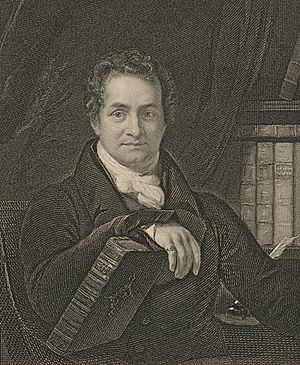
The books were kept in five rooms in the west wing, which together formed the "Long Library." Books filled the shelves from floor to ceiling along its 200-foot (61-meter) length. He collected not only British books but also Greek and Latin classics. In 1790, he bought the collection of Count Charles de Revicksky. George often paid high prices for rare books, including a woodcut from 1423 and the Mazarin Bible of 1455. In 1812, George John was in a fierce bidding war for a copy of Boccaccio's The Decameron, one of only three known copies. He later bought it for £750.
In 1802, George hired Reverend Thomas Frognall Dibdin as the official librarian to care for the collection. The library contains his many catalogs, which list the books. The collection became so huge that the library couldn't hold all the books. Books started to be stored in the long picture gallery on the first floor above it. By the time George John died in 1834, he had one of the largest private collections in Europe, with about 110,000 books.
Billiard Room
The billiard room is between the south drawing room and the library. It looks out over the deer park. This room was once called the "Rubens room." Charles Spencer once described it as a "dead space" with uncomfortable furniture. The room has now been "brought to life" with many horse and sporting paintings. It also has a full-sized billiard table that was moved from the stables in the 1990s. The room also contains a bronze sculpture of Forager, the Red Earl's favorite foxhound, from 1893.
China Museum and Porcelain
The old "painter's passage" was changed after the Second World War. Glass cases were put in to show off the Spencer family's dishes and porcelain. This included pieces from famous makers like Meissen and Sèvres. Charles Spencer said his grandfather Albert wanted to show off the treasures in an organized way. Today, most of this collection has been moved to the China Museum on the east side of the house. The passage now has busts and paintings, including a self-portrait by Sofonisba Anguisciola. Charles Spencer's favorites in the museum are a pair of blue and white tulipieres (special vases for tulips) from the late 1600s.
The Garden Lobby at Althorp also has many porcelain pieces from Europe and some rare pieces from Asia. Notable items include a Sèvres tobacco jar, two Chelsea vases, a finely carved Meissen flower bowl, and a blue and gold Meissen chocolate set that was believed to have been made for Marie Antoinette in 1781.
First Floor Rooms
The Picture Gallery and Chapel
The Picture Gallery is 115 feet (35 meters) long on the first floor of the west wing. It's one of the best examples of the original Tudor oak wood and feel in the house. During renovations in the 1700s, the oak panels were painted white. They were restored to their original look in 1904. Because it was so long, ladies of the house used the gallery for exercise on rainy days to avoid getting their long dresses muddy outside. It was also used as a dining hall.
The gallery has a large collection of about 60 portraits. These include War and Peace by Van Dyck, a portrait of James I, and a portrait of Charles II. A visitor in 1748 described the paintings as having "gracefulness and life" and "strength of colouring." The portraits are in fancy gold frames designed by Robert Spencer, the Second Earl. Albert Spencer was very protective of War and Peace, once the most valuable item at Althorp. He had a window in the gallery changed into a door so the painting could be safely moved out in case of a fire. There's also a small hidden door that leads to a staircase and a guest bedroom.
The chapel on the upper floor became a storage room in the early 1980s for items being sold. The stained glass window in the chapel, with the Spencer family crest, dates back to 1588. The organ is much newer, from the 1990s. Some earlier owners of Althorp were very religious and would preach in the chapel. It is still used for family christenings and services at Christmas, Easter, and Thanksgiving.
Notable paintings on the upper floor
-
War and Peace by Sir Anthony van Dyck (1637)
Bedrooms
The Oak Bedroom is at the back of the house, on the western side. The first Earl Spencer and Margaret Georgiana secretly got married here on December 20, 1755, during a ball celebrating John's 21st birthday. As of 1998, it had deep red wallpaper, rug, and chairs, with oak floors and furniture. Several portraits hang on the walls.
The Great Room is next to the Oak Bedroom. It was set up in the mid-1600s as a reception area. George John, the Second Earl, used it for important political meetings. The Great Room is mostly red and gold. It has a table and chairs with a large gold mirror. The long mirror has the Spencer family coat of arms at the top. The Great Room has many small portraits, including a rare one of Lady Jane Grey as a teenager.
The Princess of Wales Bedroom is named after Alexandra, Princess of Wales, who stayed at Althorp in 1863. The room is mostly Georgian, with deep red walls and furnishings. It has a notable portrait of a young princess. The Queen Mary Bedroom is named after Mary, the wife of King George V, who visited Althorp in 1913. It has a very tall bed from the 1700s. Two chairs in this room have needlework made by Albert, who was chairman of the Royal School of Needlework.
The upper floor also has the India Silk Bedroom and the Ante Room. The Ante Room was once called the Patchwork Bedroom and was set up by Charlotte, Countess Spencer and her sister in the Victorian period. Today, it's part of a suite of state rooms.
Other Buildings
The Althorp estate has 28 listed buildings and structures. Two are very important (Grade I listed), including the main house. Two are also very important (Grade II* listed), like the stable block and Gardener's House. The rest are important (Grade II listed), mainly garden screens, gates, and planting stones.
The mustard-yellow stable block was designed by architect Roger Morris in the early 1730s. It replaced an older building and could hold 30 to 40 horses. It has a clear Tuscan architectural style. The stable block was used as an exhibition center to celebrate the life of Princess Diana from 1998 to 2013. Now, it hosts a yearly exhibition about a theme of the estate. In 2019, the exhibition was called 'Animals of Althorp.'
The Falconry, built in 1613, is also a very important building. It's a two-story building with a red-brick extension added in the 1800s. Over the years, it has been home to the park warden, gamekeeper, and kennelman. Both the stable block and Falconry became listed buildings in 1954.
The Gardener's House, built in a similar style, is at the back of the park. The head gardener of Althorp lived there in the 1700s. It has a notable Victorian marble sculpture called The Shipwrecked Mariner. Charles Spencer moved it from the Gardener's House to the main house.
The North and South West Lodges of Althorp were built around 1730. The North and South East Lodges were built around 1810. All four buildings became listed buildings in 1954. The Dairy Cottage, near the lake, dates to the late 1700s.
The Grounds
The Althorp estate covers at least 13,000 acres (53 square kilometers). It includes the house grounds, woodlands, cottages, farms, and nearby small villages. The soil is rich and dark. Within the grounds, you can find traces of the old village of Althorp, which the estate was built on.
There are several woods on the estate, like High Wood and Sir John's Wood. Sir John's Wood is named after John Spencer, who planted many woods in the late 1500s. Between 1567 and 1901, at least seven stone tablets were put up in the park to remember the tree plantings. In the northern part of Althorp, there's marshy ground where herons used to feed. Herons were once a prized food at the house.
Robert Spencer hired the French landscape architect André Le Nôtre to design the park and grounds in the 1660s. A map from 1709 shows the changes, with the house having a large rectangular courtyard, a formal garden, and tree-lined paths. During renovations in the 1700s, the lake in the deer park was drained.
From 1860 onwards, the architect William Milford Teulon updated the gardens. More changes were made in the 1990s by Dan Pearson when the Diana memorial was created and many trees were planted. After Teulon's work, the Spencers started growing their own fruits, vegetables, and flowers. In 1901, a new type of sweet pea flower, now called "Spencer type," was grown at Althorp. It had "flowers of exceptional size and of an exquisite shade of pink."
Diana's Resting Place and Memorial
Diana, Princess of Wales, was buried on a small island in the middle of the Round Oval lake. This lake was created in 1868. The island was chosen as the best place for her to rest because the water would "act as a buffer against the interventions of the insane and ghoulish," according to Charles Spencer. The ground was blessed by the Bishop of Peterborough before the burial. Her burial place is marked with a white memorial stone and urn.
A temple with Diana's name on it is across from the lake. It's a place where visitors can leave flowers for the princess. It has a black outline of her in the middle, set in white marble. One side of the temple has a quote from Diana about her love for charity work. The other side has Charles Spencer's tribute from her funeral. This temple was originally built by George Spencer, 2nd Earl Spencer, to thank God for a British victory in a battle.
After Diana's death on August 31, 1997, and the decision to create a memorial and open the house to the public, garden designer Dan Pearson was asked to update the park and gardens for visitors. Thirty-six oak trees were planted along the access road, one for each year of Diana's life. Thousands of plants were planted, including 100 white roses on the island and 1,000 white water lilies in the lake.
The estate's stable block was turned into a public exhibition about Diana. It was open from 1998 to 2013. It was designed to show a mix of modern and old, like Diana herself. Six rooms were created from the old carriage houses and stables. The old tea room became a restaurant.
The first room was called "Spencer Women," showing Diana in the context of the women in her family. The next room had four minutes of video footage of Diana as a child. It showed her christening, first birthday, first steps, and her love for animals. This room also had her childhood items like her tuck-box, toy typewriter, and ballet shoes.
A third room showed the Royal Wedding and its excitement, with a display of her wedding dress. A fourth room showed her charity and humanitarian work through video. A fifth room was called the "Tribute Room."
The sixth room was the Exhibition, celebrating her life. It had large glass cases with mannequins of Diana wearing her famous suits and dresses. A huge glass case at the end held hundreds of the thousands of condolence books the Spencers received from around the world. A special copy of her brother Charles's speech from her funeral was also available.
The estate and house are open to the public during the summer (July 1 to August 30). The exhibition center in the stable block closed in August 2013. It was believed this was to avoid making Diana's name too commercial. The items on display have been packed up and are intended to be given to her sons, William and Harry. All profits made were donated to the Diana, Princess of Wales Memorial Fund, which closed in 2012.
Ghost Stories
While the current owner, Charles Spencer, says he has never seen a ghost at Althorp, many ghostly sightings have been reported over the years. In the mid-1800s, a visitor complained that a figure dressed as a groom (believed to be the ghost of a deceased servant) entered his room at night, checking candles. Lady Margaret Douglas-Home also said she was aware of a ghost of a girl with grey slippers in the gallery.
See also
- List of historic houses in England


